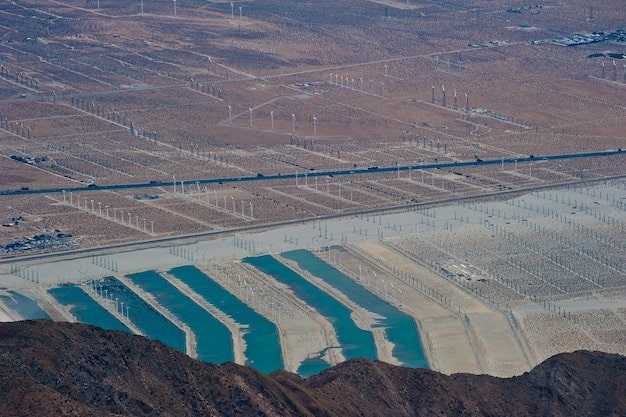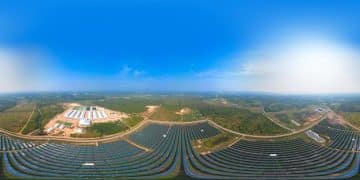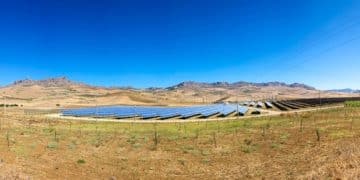Long-Term Economic Benefits of Investing in US Renewable Energy Infrastructure

Investing in renewable energy infrastructure in the US offers substantial long-term economic benefits, including job creation, reduced energy costs, improved public health, enhanced energy security, and mitigation of climate change impacts, fostering sustainable economic growth.
The shift towards renewable energy sources is not merely an environmental imperative but also a significant economic opportunity. Understanding What are the Long-Term Economic Benefits of Investing in Renewable Energy Infrastructure in the US? is crucial for policymakers, investors, and citizens alike. Let’s explore the multifaceted advantages of embracing a green energy future.
Renewable Energy Investments: A Catalyst for Job Creation
One of the most immediate and tangible economic benefits of investing in renewable energy infrastructure is the creation of jobs. From manufacturing and installation to maintenance and research, the renewable energy sector offers diverse employment opportunities.
The traditional fossil fuel industry is increasingly automated, leading to fewer jobs. Renewable energy, however, is more labor-intensive. Let’s delve into how this job creation unfolds across various sectors:
Manufacturing and Construction
Building renewable energy infrastructure, such as solar farms and wind turbines, requires a significant manufacturing and construction workforce. This includes engineers, technicians, and skilled laborers.
Installation and Maintenance
Once the infrastructure is built, there’s a need for ongoing maintenance and operation. Solar panel cleaning, wind turbine repairs, and grid management create long-term employment.
- Renewable energy technologies require specialized skills, leading to training programs and educational opportunities.
- Local economies benefit from increased employment, boosting consumer spending and tax revenues.
- Job creation in renewable energy can help revitalize economically distressed areas.
- The renewable energy sector fosters innovation, leading to the development of new technologies and further job growth.
The shift towards renewables creates a more diversified job market and reduces dependence on volatile fossil fuel industries. These jobs tend to be more stable and less susceptible to boom-and-bust cycles.

Lower Energy Costs and Increased Energy Independence
Investing in renewable energy can stabilize and even lower energy costs over the long term. Unlike fossil fuels, which are subject to price volatility and geopolitical instability, renewable energy sources are domestically abundant and less prone to market fluctuations.
By reducing reliance on imported fossil fuels, the US can enhance its energy independence and reduce its exposure to international energy market shocks. Let’s examine the mechanisms through which renewable energy achieves these benefits:
Reduced Fuel Price Volatility
The cost of renewable energy is largely determined upfront during construction. After that, the “fuel” (sun, wind, water) is free. This insulates consumers and businesses from the fluctuating prices of fossil fuels.
Diversification of Energy Sources
Relying on a mix of renewable energy sources reduces the risk of price spikes associated with any single energy commodity. This diversification is a key component of energy security.
Renewable energy infrastructure investments can also lead to lower electricity bills for consumers and businesses. This is especially beneficial for low-income households and energy-intensive industries.
Investments in grid modernization and energy storage technologies enable more efficient use of renewable energy, further reducing costs. These technologies optimize energy distribution and minimize waste.
In summary, renewable energy offers a hedge against energy price volatility, enhances energy independence, and reduces the financial burden of electricity costs for households and businesses.
Health Benefits and Environmental Protection
The health and environmental benefits of renewable energy investments are often overlooked in purely economic analyses, but they represent significant long-term value. Reducing air and water pollution leads to improved public health outcomes and lower healthcare costs.
Fossil fuel combustion releases harmful pollutants, such as particulate matter and nitrogen oxides, which contribute to respiratory illnesses and other health problems. Let’s look at how renewable energy addresses these issues:
Reduced Air Pollution
Renewable energy sources like solar and wind produce electricity without burning fossil fuels, thereby emitting no air pollutants. This leads to cleaner air and reduced incidents of respiratory diseases.
Water Conservation
Fossil fuel and nuclear power plants require significant amounts of water for cooling. Renewable energy technologies like solar photovoltaic and wind power use little to no water, conserving this precious resource.
- Reduced healthcare costs associated with pollution-related illnesses.
- Improved air and water quality, leading to a healthier population.
- Mitigation of climate change impacts, reducing the risk of extreme weather events.
- Conservation of natural resources, protecting ecosystems and biodiversity.
The health and environmental benefits of renewable energy investments translate into long-term economic gains through reduced healthcare expenditures and a more sustainable environment.
Stimulating Innovation and Technological Advancement
Investing in renewable energy infrastructure fosters innovation and technological advancement across various sectors. This continuous improvement drives down costs, enhances efficiency, and creates new economic opportunities.
The renewable energy sector is a hotbed of technological innovation, attracting research and development investments from both public and private entities. Let’s explore how this innovation unfolds:
Research and Development
Investments in renewable energy R&D lead to breakthroughs in solar cell technology, wind turbine design, and energy storage solutions. These advancements improve the performance and affordability of renewable energy.
Grid Modernization
Integrating renewable energy into the grid requires advanced grid management technologies, such as smart grids and real-time monitoring systems. These technologies enhance grid reliability and efficiency.
Innovation in renewable energy also spills over into other sectors, such as transportation and manufacturing. Electric vehicles, for example, benefit from advancements in battery technology spurred by the renewable energy sector.
The pursuit of renewable energy solutions encourages interdisciplinary collaboration, bringing together experts from various fields to solve complex problems. This fosters a culture of innovation and continuous improvement.
Ultimately, investments in renewable energy stimulate technological advancement, driving economic growth and creating new high-tech industries.

Increased Property Values and Local Economic Development
Renewable energy projects can increase property values in surrounding areas and stimulate local economic development. This is particularly true for communities that host renewable energy facilities or manufacture renewable energy components.
Clean energy projects can enhance the attractiveness of a region and attract new businesses and residents. Consider these impacts:
Enhanced Attractiveness
Communities that embrace renewable energy are often seen as progressive and environmentally responsible, making them more attractive to businesses and residents.
Job Creation
The construction and operation of renewable energy facilities create local jobs and boost the local economy through increased spending and tax revenues.
- Increased property values due to improved aesthetics and environmental quality.
- Attraction of new businesses and investment opportunities.
- Revitalization of economically distressed areas through job creation and local spending.
- Increased local tax revenues, supporting public services like schools and infrastructure.
Local economic benefits often extend beyond the immediate vicinity of renewable energy projects. Supply chain companies, for example, may locate in nearby areas to support the industry.
In short, investing in renewable energy not only benefits the environment but also stimulates economic growth and increases property values at the local level.
Climate Change Mitigation and Resilience
One of the most significant long-term economic benefits of investing in renewable energy infrastructure is the mitigation of climate change impacts. By reducing greenhouse gas emissions, renewable energy helps to avoid the costly consequences of climate change, such as extreme weather events and sea-level rise.
Climate change poses a significant threat to the US economy, with potential impacts ranging from agricultural losses to infrastructure damage. Renewable energy offers a pathway to reduce these risks.
Reduced Greenhouse Gas Emissions
Renewable energy sources like solar, wind, and hydro produce electricity with little to no greenhouse gas emissions, reducing the overall carbon footprint of the energy sector.
Extreme Weather Resilience
A distributed renewable energy system can be more resilient to extreme weather events than a centralized fossil fuel system. Localized renewable energy sources can continue to operate even if parts of the grid are disrupted.
Climate change mitigation also creates new economic opportunities, such as the development of carbon capture technologies and the growth of the green building sector.
Investing in renewable energy is an investment in long-term economic stability and resilience. It reduces the risks associated with climate change and creates new opportunities for sustainable economic growth.
Policy Support and Investment Incentives
Government policies and investment incentives play a critical role in accelerating the deployment of renewable energy infrastructure and maximizing its economic benefits. Policies such as tax credits, renewable energy standards, and carbon pricing can create a favorable investment climate.
Supportive policies can reduce the upfront costs of renewable energy projects and increase their financial attractiveness to investors. Consider these examples:
Tax Credits
Tax credits for renewable energy investments can significantly reduce project costs, making them more competitive with fossil fuel alternatives.
Renewable Energy Standards
Renewable energy standards require utilities to source a certain percentage of their electricity from renewable sources, creating a guaranteed market for renewable energy projects.
- Policy certainty encourages long-term investment in renewable energy.
- Incentives can stimulate innovation and technological advancement.
- Supportive policies can level the playing field and make renewable energy more competitive.
- Public-private partnerships can leverage private capital for renewable energy development.
Effective policies can unlock the full economic potential of renewable energy and accelerate the transition to a sustainable energy future. In conclusion, the combination of forward-thinking policies, technological innovation, and strategic investments will drive the long-term economic benefits of renewable energy infrastructure in the US.
| Key Point | Brief Description |
|---|---|
| 🏭 Job Creation | New jobs in manufacturing, installation, and maintenance. |
| ⚡ Lower Energy Costs | Reduced fuel price volatility and energy independence. |
| 🌱 Health Benefits | Reduced air pollution and improved public health. |
| 📈 Innovation | Stimulating innovation and technological advancement. |
FAQ
▼
Renewable energy offers several economic benefits: job creation in manufacturing and installation, reduced energy costs through stable pricing, and stimulation of local economies through increased property values and tax revenues.
▼
Renewable energy reduces reliance on imported fossil fuels, enhancing national energy security and insulating economies from volatile global energy markets, which can lead to more stable energy costs.
▼
Government policies such as tax credits, renewable energy standards, and carbon pricing incentivize renewable energy investments, level the playing field against fossil fuels, and encourage private sector participation.
▼
By decreasing air and water pollution from fossil fuel combustion, renewable energy leads to fewer respiratory diseases and lower healthcare costs, promoting a healthier population overall and improving quality of life.
▼
Yes, renewable energy significantly reduces greenhouse gas emissions, which helps to mitigate the impacts of climate change, such as extreme weather events and sea-level rise, thus protecting communities and natural resources.
Conclusion
Investing in renewable energy infrastructure in the US is more than an environmental necessity; it’s an economic imperative. The long-term economic benefits, including job creation, reduced energy costs, improved public health, enhanced energy security, and climate change mitigation, make it a strategic investment for a sustainable and prosperous future.





